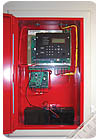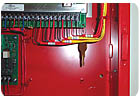INTEGRATED SYSTEMS: Crisis Notices: Integrate with Security & Life Safety

Upgraded panels include emergency notification functionality to meet new standards and overcome existing facility obstacles.
Higher standards for enterprise security, fire safety and emergency notification have changed the rules of specifying, engineering, installing and maintaining facility systems.
One example: Los Angeles International Airport has a 24-hour surveillance system with hundreds of fixed or zoom cameras sprawled throughout the airport. This network of video signals running throughout the airport was costly to maintain with the pre-existing coaxial cables that were in place. Looking to improve emergency communications and reduce costs, officials laid single-mode fiber.
Now camera feeds from taxi stands to parking structures and from terminals to tarmacs are routed to the main police dispatch station. Greater video detail and remote pan-tilt-zoom give security the tools they need in order to evaluate suspicious behavior, report medical emergencies, control crowds and dispatch officers.
Another example: The importance of Texas schools meeting enhanced district standards for emergency notification was demonstrated by the recently completed installation and approval of an integrated system at Dezavala Elementary School in the San Marcos Independent School District. The strategy included interactive communications between the school office, classrooms and other facilities of approximately 70,000 sq. ft.
Just two weeks prior to completion of the Dezavala project, Buda Lower Elementary School, a 30,000 sq. ft. structure in the Hays Consolidated Independent School District, incorporated new technologies and automated functionalities to enhance protection of the facilities, and protect the lives of students and faculty.
Installed by JM Electronic Engineering (JMEE), Round Rock, Texas, both new systems reflect a trend among school districts, airports and corporate organizations toward higher standards in alarm and emergency notification systems.
“Today’s systems must meet newly developed standards that reflect the highest concern for system quality, reliability and support,” said Robert Marsh, facility planner for the Killeen School District. “Installation is also a primary concern. Not only do we require that alarm systems meet exact specifications, but installation procedures including construction services must be coordinated with school staff, must include thorough documentation and must be performed in a timely, turnkey manner.”
Time for new rules
Surprisingly, many existing emergency notification systems are virtually unintelligible inside many structures. As a result, people are tempted to go outdoors to hear the speaker system, which can be a mistake depending on the type of emergency. New technologies, however, can provide a clear voice system within each building with a central command post. Such a centralized system can facilitate communication between individual buildings, if necessary, for delivery of specific instructions.“The days of installing alarm and notification systems piecemeal, or bidding bargain equipment and working daylight hours, are in the past,” said integrator J.J. Moore. “The rules have changed, and so should expectations and contractor requirements.”

First visit approval by an authority with jurisdiction? Clear labeling according to telecommunications standards is the key.
Set proper standards
“Thanks partly to JMEE, we have set high alarm system standards that are becoming uniform throughout the district,” said Marsh. “This is increasingly important and includes a lot of details. For example, we have very thorough documentation on entire systems in a standardized manner with color-coded drawings and all the data on how systems are hooked up, voltage calculations and so on. When you look at one of our drawings, you don’t have to guess how a piece of equipment or system was installed or wired; we have a reference.”He added that the schools in his district keep all records and documentation on a computer server. Every computer program for the panels is also on a server as backup. Information can be downloaded into the panels via phone or the Internet.
Like many other areas, schools in the Killeen district have experienced problems getting approval on fire marshal inspections. “It used to be a frequent problem, requiring three or four tries,” said Marsh. “I have to deal with multiple jurisdictions in this district: federal, city and county, plus separate local jurisdictions that have differing standards for installation and maintenance service. Now JMEE deals with all of that, so it is not even an issue as far as the school district is concerned. Typically, all of our new installations pass fire marshal inspection on the first try.”
Marsh attributed his success with fire marshal inspections to the overall quality of system installation. “We probably do a more thorough job than most organizations,” he said. “Every single device has printed label attached to it. Every fire panel and every booster has its own individual ID so a service tech who has not been to that school before does not have to guess. When you open a panel, everything is labeled according to telecommunications standards. Every single wire in the control panel has a machine-printed label on it that shows what it is and where it is supposed to be connected on the panel.”
Boeing Goes Intelligent Video
Boeing Company, in a move to increase its security, safety and emergency notification systems, is adding behavior recognition and intelligent video monitoring technologies to some of its facilities.St. Louis-based Cernium’s Perceptrak system will analyze images from security video feeds in real-time and alert security personnel to certain pre-defined human or vehicular behaviors that may require further observation or action.
The technology represents the latest development in object and behavior recognition, with the system able to distinguish between a catalog of distinct human and vehicular behaviors, such as a fallen person, lingering individuals or vehicles, erratic movement, abandoned objects, unauthorized personnel or vehicles in restricted areas, among others.
Links
Looking for a reprint of this article?
From high-res PDFs to custom plaques, order your copy today!





